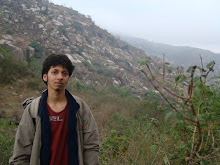 |
| Solar thermal - Parabolic reflectors |
I had heard a lot about the sustainability story of this place in Gujrat from one of my mentors at work. After planning for weeks, I and my colleagues finally managed to block the calendars of Vikram and Deepak who are the men behind Muni Seva Ashram. The word ‘Ashram’ is usually associated with religion but this place has no such associations.
 |
| Cancer hospital |
Three of us from Infosys landed in Baroda on the evening of Sep 2
nd and then hired a cab to Goraj, which is an hour drive from Baroda airport. We checked into our air conditioned rooms and I almost forgot that I was in a remote village in India. We met Vikram and Deepak in the meeting room and they started briefing us about the projects implemented in the ashram.This place has electricity 24X7 and is powered mainly by Solar and biomass. Solar lighting, heating, air conditioning, cooking; biogas, biomass gascification, cyclotron, plasma pyrolysis, water treatment plants, organic farming in a 700 acre field, residential school, state of the art cancer hospital where treatment is affordable to people even from the rural villages, home for the mentally challenged, Senior citizens, Orphanage, Nursing college, animal house, biogas bottling plant are some of the projects and the list goes on. Deepak brought solar thermal technology to India way back in the 80’s and it is widely used in the ashram. The best part of the whole concept is that they have not only achieved environmental sustainability, but also significantly impact the social and economic dimensions. They are 70% economically sustainable and I feel this is an incredible achievement.
Although they are supported by donations, this is no charity stuff. Vikram happens to be a doctor by profession, but is also the mastermind behind most of the engineering projects here and is a passionate farmer. Deepak left Germany and came back to India and his work here will definitely inspire generations to come. Over the next two days, we visited their project sites and had extensive debates and discussions regarding various case studies, models, technologies mainly concerned with rural areas. For me personally, this visit was enlightening.
 |
| Biogas bottling plant |
My area of interest is biomass energy recovery and I visited a CBG (biogas bottling) plant for the first time here. I spent most of my time here learning the practical knowledge of biomass gasification, bottling, advanced waste management solutions such as pyrolysis, etc. We visited many biogas plants and composting units and this tour has strengthened my belief that biomass is the future of energy sustainability.
 |
| Biogas plant |
The residential school which they have built is located in a hundred acre farm where only organic method of cultivation is practiced. Huge parabolic reflectors are installed on the terrace of the building and the heat is used for cooking and boiling water.
Thick biomass, twigs and other hard woody materials are gasified and cow dung from livestock goes into the biogas plant.
Another interesting innovation which I came across in their kitchen was the solar cooker. Unlike, the conventional solar cooker which uses, water/steam as a source of thermic fluid, they use a specially imported edible oil which is used for heat transfer in the cooker and is a closed-loop system.
They have also built the world’s first Solar crematorium and have managed to convince people to use the service.
 |
| Solar crematorium |
Solar air conditioning and VAM are the two main technologies used in cooling. The buildings are designed to incorporate natural ventilation and day lighting. Water recycling is 100 percent – They have a Sewage treatment plant in the campus and water recharging is done across their farms.
This place is a transformation and if you ever go to Gujrat, do visit Goraj and meet these men. It’s a remarkable story of Sustainability and if we can replicate this model in our cities and villages, the entire country can achieve resource sufficiency.








Commnedable!! But, who owns this 700 acres of land?? Is it owned by Gujarat government??
ReplyDeleteCommnedable!! But, who owns this 700 acres of land?? Is it owned by Gujarat government??
ReplyDeleteThis includes usage of waste tyres as a raw material and produce green fuel oil, carbon black, steel and gas out of it.
ReplyDeleteManufacturer Of Tire Pyrolysis Plants
Biomass based industries can provide employment opportunities and promote biomass regrowth through sustainable land management practices.
ReplyDeleteInstitutional Biogas Plant in Bangalore